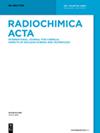伊拉克婴儿食品中的铀浓度及其同位素
IF 1.4
3区 化学
Q4 CHEMISTRY, INORGANIC & NUCLEAR
引用次数: 0
摘要
本研究利用固态核轨道探测器技术(CR-39)测定了从伊拉克市场收集的婴儿食品样本中的铀浓度和同位素(238U、235U 和 234U)。此外,还利用理论方程计算了同一研究样本的一些辐射危害参数,如年承诺有效剂量(E U)和每百万人癌症死亡超额风险(RECFPMP)。本次研究的样本分为三个品种:谷物和谷物制品、蔬菜和水果以及饼干。结果显示,谷物和谷物制品、蔬菜和水果以及饼干中铀的平均浓度值(毫克/千克或 ppm)分别为 0.71 ± 0.01、0.81 ± 0.04 和 0.72 ± 0.031。同时,本次研究中所有样品中 238U、235U 和 234U 的平均值分别为 9.08 ±0.17 Bq/kg、0.42 ± 0.0081 Bq/kg 和 9.33 ± 0.18 Bq/kg。谷类和谷类制品、蔬菜和水果以及饼干中所有铀同位素(238U、235U 和 234U)引起的 E U 总平均值(mSv/y)分别为 0.042 ± 0.0006、0.039 ± 0.001 和 0.034 ± 0.001。此外,还发现谷物和谷物制品样本中的 RECFPMP 平均值为 0.159 ± 0.002,蔬菜和水果样本中的 RECFPMP 平均值为 0.154 ± 0.007,饼干样本中的 RECFPMP 平均值为 0.130 ± 0.005。所有婴儿食品样本中的铀浓度和每年承诺的总有效剂量都符合联合国辐射防护委员会批准的全球限值,即安全限值(1.7 毫克/千克)和(0.32 毫希沃特/年)。因此,我们可以得出结论,婴儿食用的铀浓度不存在危险。本文章由计算机程序翻译,如有差异,请以英文原文为准。
Uranium concentrations and its isotopes in baby food of Iraq
This study determines uranium concentrations and isotopes (238 U, 235 U, and 234 U) in baby food samples collected from Iraqi markets using solid-state nuclear track detector technical (CR-39). Also, some radiological hazard parameters such as annual committed effective dose (E U ) and risk of an excess cancer fatality per million persons (RECFPMP) for the same study samples were calculated using theoretical equations. The samples in the present study were classified into three varieties: cereals and cereal products, vegetables and fruits, and biscuits. The results show that the average uranium concentration (mg/kg or ppm) values in cereals and cereal products, vegetables and fruits, and biscuits were 0.71 ± 0.01, 0.81 ± 0.04, and 0.72 ± 0.031, respectively. At the same time, the average values of 238 U, 235 U, and 234 U in all samples of the present study were 9.08 ±0.17 Bq/kg, 0.42 ± 0.0081 Bq/kg, and 9.33 ± 0.18 Bq/kg, respectively. The total average of E U (mSv/y) due to all uranium isotopes (238 U, 235 U, and 234 U) in cereals and cereal products, vegetables and fruits, and biscuits were 0.042 ± 0.0006, 0.039 ± 0.001, and 0.034 ± 0.001, respectively. Moreover, it was found that the average values of RECFPMP were 0.159 ± 0.002 in cereals and cereal products samples, 0.154 ± 0.007 in vegetables and fruits samples, and 0.130 ± 0.005 in biscuits samples. Uranium concentrations and the total annual committed effective dose in all baby food samples comply with the worldwide limits approved by UNSCEAR, which state safe limitations (1.7 mg/kg) and (0.32 mSv/y), respectively. So, one may conclude that there is no danger of uranium concentrations in the case of baby consumption.
求助全文
通过发布文献求助,成功后即可免费获取论文全文。
去求助
来源期刊

Radiochimica Acta
化学-核科学技术
CiteScore
2.90
自引率
16.70%
发文量
78
审稿时长
6 months
期刊介绍:
Radiochimica Acta publishes manuscripts encompassing chemical aspects of nuclear science and technology.
 求助内容:
求助内容: 应助结果提醒方式:
应助结果提醒方式:


